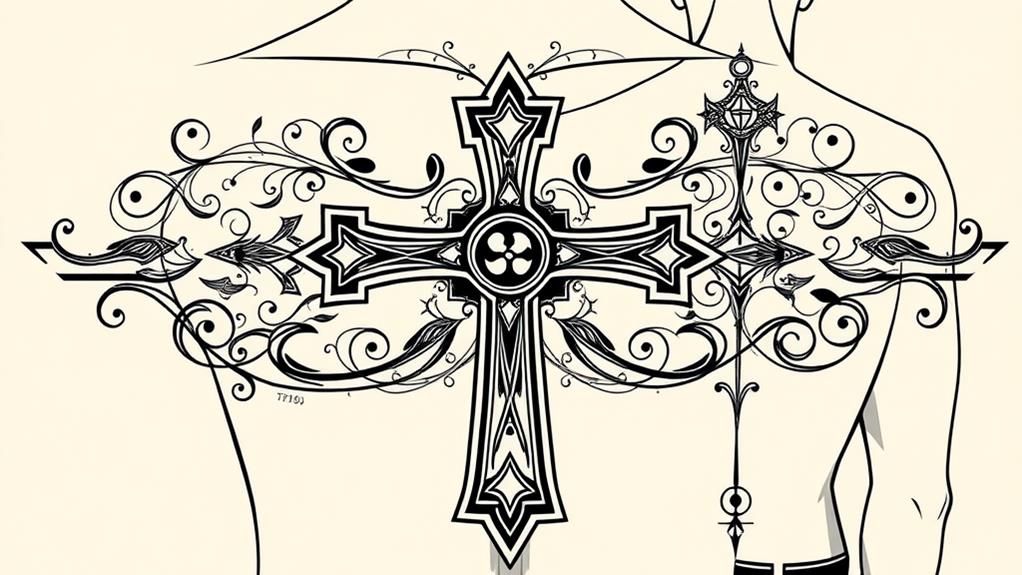Coptic cross tattoos are a lively symbol of my Coptic Orthodox Christian heritage, embodying centuries of resilience, hope, and devotion. These intricate designs, rooted in early Egyptian Christianity, tell stories of my ancestors' steadfast faith and sacrifice. My tattoo is a personal badge of honor, connecting me to a rich legacy of spiritual commitment and cultural identity. Whether you prefer traditional or modern designs, these tattoos are a significant statement of belonging. Each element, from the cross's shape to its placement, carries deep meaning. There's so much more to uncover about these powerful symbols.
Origin and History
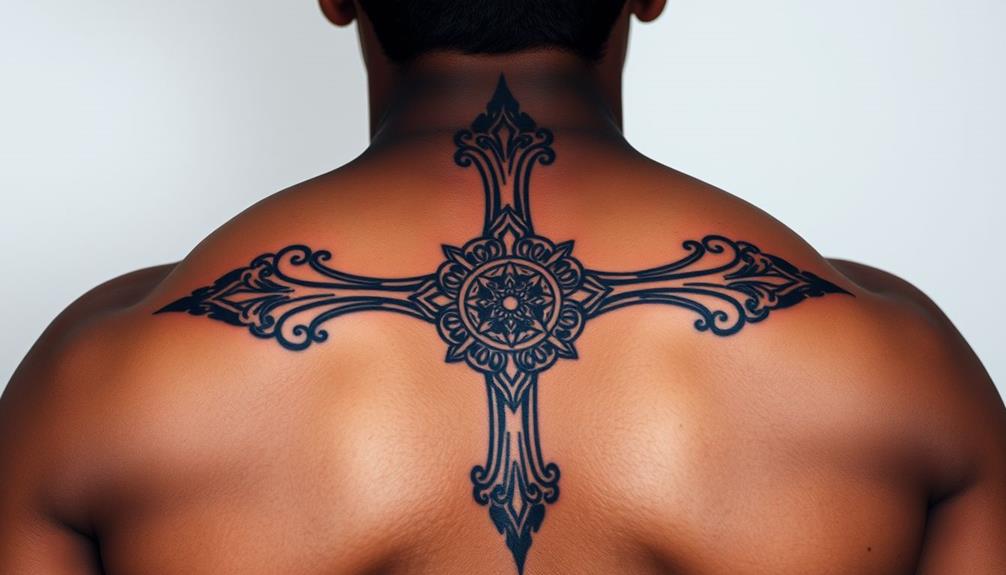
The Coptic cross tattoo, a symbol deeply ingrained in the Coptic Orthodox Christian tradition, traces its roots back to the early days of Christianity in Egypt.
As I explore the rich fabric of Coptic heritage, I'm fascinated by the ancient artistry that has shaped this powerful emblem of faith. The Coptic cross isn't merely a religious symbol; it's a reflection of the resilience and devotion of the Coptic people, who've preserved their faith through centuries of challenges.
The evolution of the Coptic cross tattoo is a captivating story of cultural fusion and personal identity. From the intricate designs etched into the walls of ancient monasteries to the modern interpretations adorning the bodies of believers, this body art has evolved while maintaining its deep religious symbolism.
For many Copts, getting a cross tattoo is a deeply personal act of faith expression, a permanent reminder of their commitment to God and their Coptic identity.
Symbolic Meanings
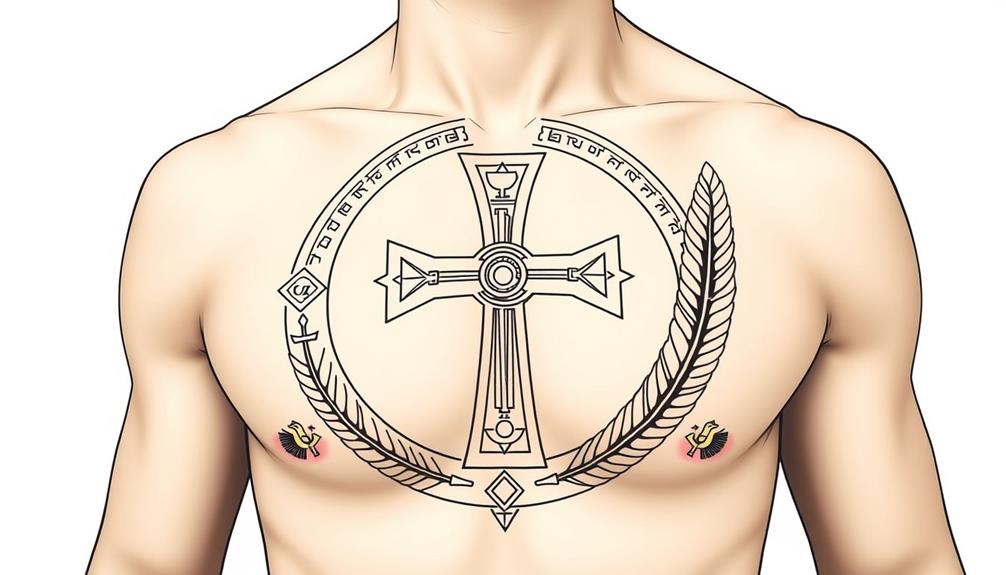
As I investigate the symbolic meanings behind the Coptic cross tattoo, I'm struck by the depth of its significance. This ancient symbol represents not only the rich history of the Coptic Orthodox Church but also the steadfast faith of its followers.
The intricate design of the Coptic cross, with its unique blend of circular and cross-shaped elements, is a reflection of the artistic variations that have evolved over centuries. Each line and curve tells a story of resilience, hope, and devotion.
For many, getting a Coptic cross tattoo is a significant expression of their faith and a way to carry their spiritual beliefs with them wherever they go.
It's a constant reminder of the sacrifices made by Christ and the love that God has for His people. The tattoo becomes a deeply personal statement, a way to connect with one's heritage and spirituality on a daily basis.
Traditional Designs
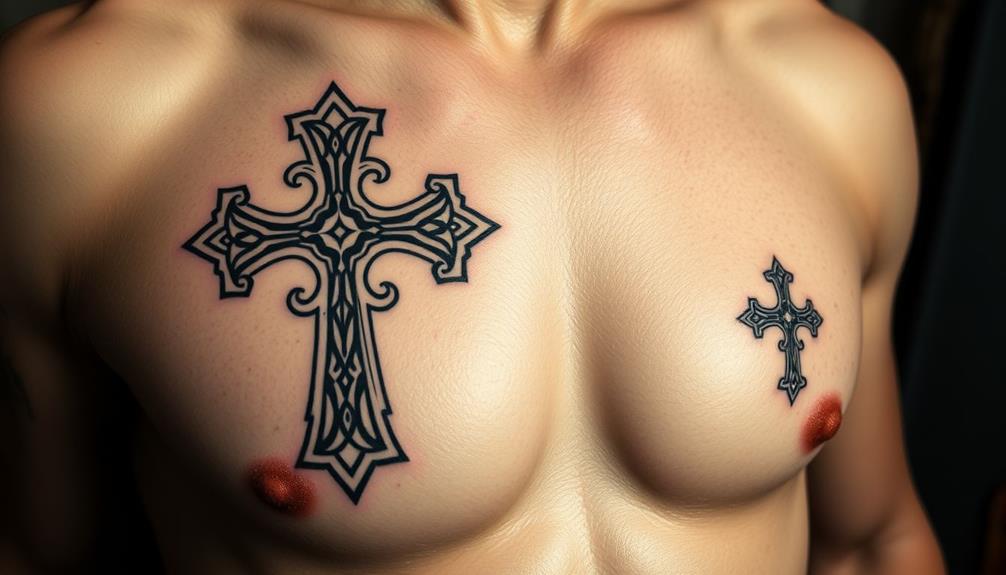
Turning our attention to the traditional designs of Coptic cross tattoos, we find a rich mosaic of symbolism and artistry. These crosses aren't just simple or uniform; they come in a beautiful array of design variations, each with its own unique flair. Some feature intricate patterns that weave together like a fabric, while others are more minimalist, focusing on the clean lines and bold shapes of the cross itself.
What I love about these tattoos is the range of artistic styles they encompass. From the more traditional and ornate designs that harken back to the early days of Coptic Christianity, to the modern and abstract interpretations that expand the limits of what a cross can look like, there's truly something for everyone.
It's a reflection of the enduring power and versatility of this symbol that it can be reimagined in so many different ways, while still retaining its deep spiritual significance.
Cultural Significance
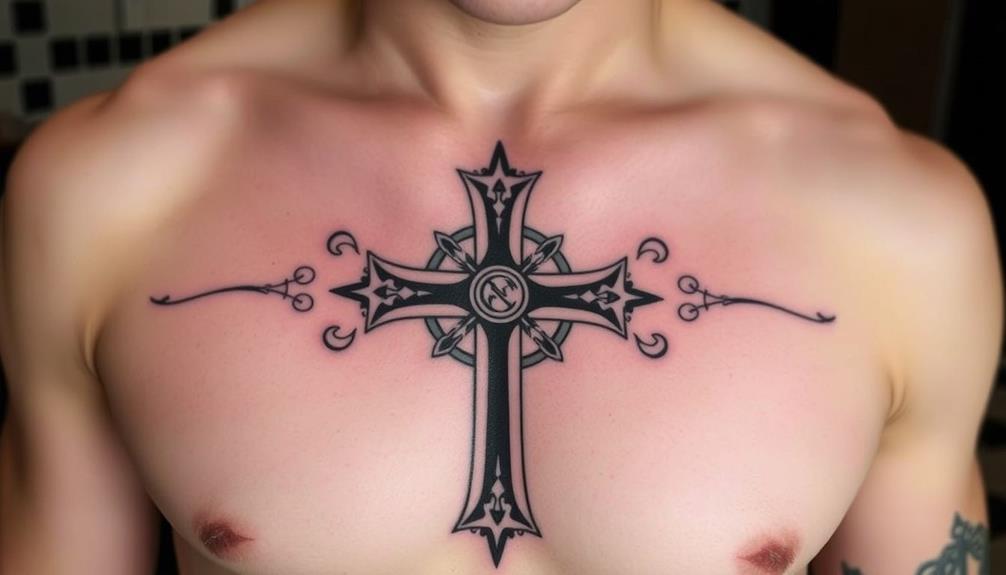
The Coptic cross tattoo isn't just a beautiful design; it's a powerful symbol with deep historical roots in Egyptian Christianity.
For those who wear it, the tattoo represents their unbreakable connection to their faith and heritage.
I'm excited to investigate the rich spiritual meanings behind this ancient symbol with you.
Historical Roots
Coptic cross tattoos hold a deep cultural significance that stretches back centuries. These ancient influences are deeply rooted in the history of the Coptic Orthodox Church, one of the oldest Christian denominations in the world. The practice of tattooing the Coptic cross has been passed down through generations, and it remains an important ritual practice for many Copts today.
The origins of the Coptic cross tattoo can be traced back to the early days of Christianity in Egypt. During this time, the Coptic Church faced persecution from the Roman Empire, and many Copts were forced to hide their faith. The tattoo of the Coptic cross served as a secret symbol of their devotion, allowing them to identify fellow believers while avoiding detection by the authorities.
Over time, the practice of tattooing the Coptic cross became more widespread and evolved into a cherished tradition. Today, many Copts choose to get the tattoo as a way to honor their heritage and express their commitment to their faith.
The tattoo is typically placed on the inside of the wrist or the back of the hand, and it's often accompanied by other religious symbols or inscriptions.
Spiritual Meanings
Embracing the Coptic cross tattoo means more than just ink on skin; it's a significant statement of faith and cultural identity. This sacred symbol, deeply rooted in the Coptic Orthodox tradition, serves as both a reminder of my spiritual expedition and an expression of my steadfast faith.
The intricate design, with its unique blend of ancient Egyptian and Christian symbolism, tells a story of resilience, devotion, and the enduring power of religious conviction. The Coptic cross isn't merely an artistic representation; it's a deep source of spiritual guidance.
Each line and curve holds a deeper meaning, pointing me towards the path of righteousness and reminding me of the sacrifices made by those who came before me. By permanently etching this symbol onto my body, I'm making a bold declaration of my faith, allowing it to become an integral part of my identity.
In a world that often seeks to silence or marginalize religious expression, my Coptic cross tattoo becomes a defiant act of devotion. It's a constant reminder that I'm part of something greater than myself, connected to a rich spiritual heritage that has withstood the test of time.
Modern Interpretations

Through the lens of modern interpretations, we see a resurgence in the popularity of Coptic cross tattoos, blending ancient traditions with contemporary styles. This fusion allows for a unique artistic expression that pays homage to the rich history of the Coptic Church while embracing the creativity of today's tattoo artists.
I've noticed that many individuals are drawn to the intricate designs and symbolic meanings behind these crosses, seeking to incorporate them into their personal narratives.
Contemporary styles have breathed new life into the traditional Coptic cross, with tattoo artists experimenting with various techniques and elements to create stunning, one-of-a-kind pieces. From minimalist designs that focus on the cross's basic shape to elaborate compositions that weave in additional symbols and motifs, there's a wealth of possibilities for those looking to express their faith or connection to Coptic heritage through body art.
As someone who appreciates the beauty and significance of these tattoos, I'm excited to see how modern interpretations continue to evolve and inspire others.
The Coptic cross's enduring appeal lies in its ability to adapt and remain relevant across generations, making it a powerful symbol of both spiritual and artistic expression.
Tattooing Techniques
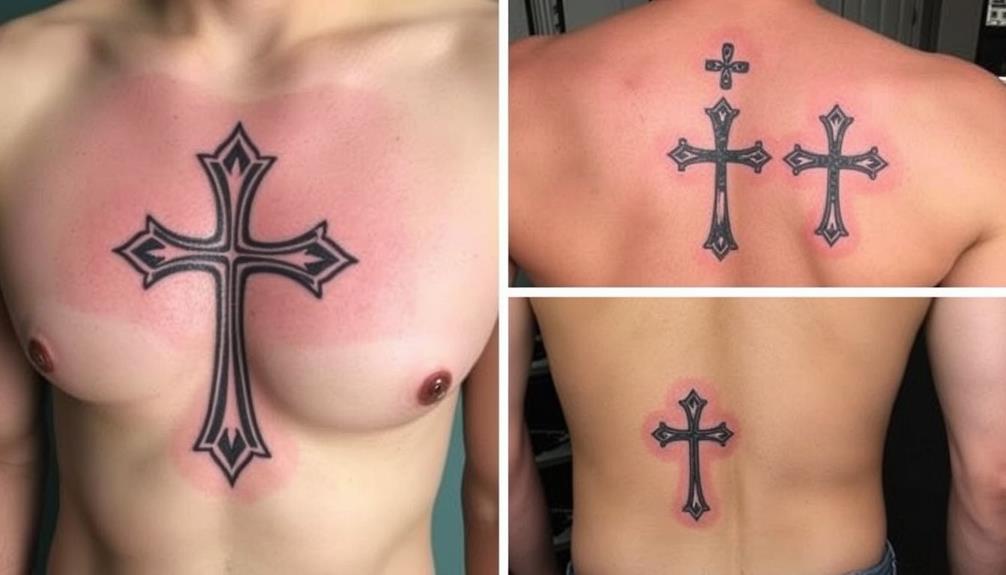
As we investigate the domain of tattooing techniques, it's fascinating to see how artists bring Coptic cross designs to life on the skin. Different needle techniques and ink types play an essential role in capturing the intricate details and symbolism of these ancient crosses.
I've seen artists use a variety of needle configurations, from single needles for fine lines to magnum shaders for filling in larger areas. The way they control the depth and angle of the needle is truly an art form, allowing them to create the perfect balance between shading and line work.
When it comes to ink types, many artists prefer to use black ink for the majority of the design, as it provides a bold contrast against the skin. However, some may incorporate hints of color, such as deep reds or rich golds, to add dimension and enhance the overall appearance of the tattoo.
Witnessing the precision and skill that goes into tattooing a Coptic cross is a reflection of the artist's dedication to their craft. It's a true blend of technical ability and creative vision, resulting in a stunning piece of body art that carries with it centuries of tradition and meaning.
Placement and Size

When it comes to placing your Coptic cross tattoo, you've got a few great options.
I recommend considering your wrist, forearm, or even your neck for a truly impactful statement.
As for size, it's essential to choose a size that complements your chosen placement and allows the intricate details of the cross to shine.
Popular Placement Options
Coptic cross tattoos hold deep meaning for those who wear them, and their placement is just as significant.
When you choose a spot for your Coptic cross, you're deciding how visible and personal you want this symbol to be. Popular placements include wrist tattoos, where the cross serves as a constant reminder of your faith, and upper arm tattoos that showcase your beliefs with satisfaction.
For a more discreet option, consider back tattoos or chest tattoos, allowing you to keep your Coptic cross close to your heart. Ankle tattoos offer a subtle yet meaningful placement, while finger tattoos make a bold statement.
Thigh tattoos provide a larger canvas for intricate designs, and neck tattoos draw attention to your devotion.
Ultimately, the placement of your Coptic cross tattoo is a personal choice that reflects your relationship with your faith and how you want to express it to the world.
Choosing Appropriate Size
Selecting the right size for your Coptic cross tattoo is essential, as it not only affects the overall appearance but also guarantees that the design complements your chosen placement.
When considering the size, I always take into account the intricacy of the design and the area of the body I'm working with. Here are some key factors to keep in mind:
- *Detail and Intricacy*: A larger size allows for more intricate details to be incorporated into the design, making it more visually appealing and meaningful.
- *Visibility and Discretion*: Depending on your preference, you may want to choose a size that's easily visible or one that's more discreet.
- *Body Area*: The dimensions of your tattoo should harmonize with the natural lines and contours of your chosen body area.
Personal Stories
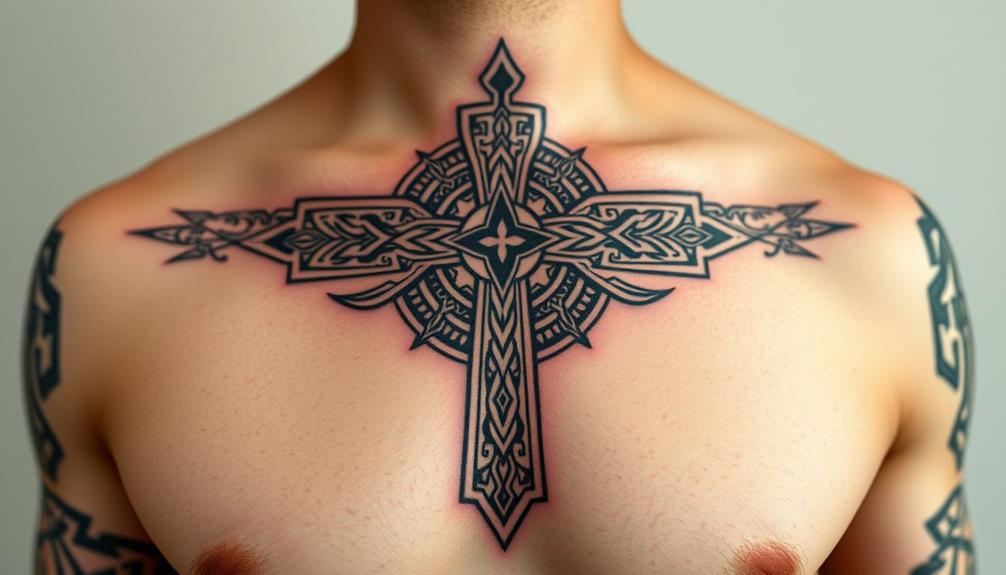
Despite the rich history and symbolism behind Coptic cross tattoos, it's the personal stories that truly bring them to life. As I've traveled through the world of tattoos, I've encountered countless individuals who've chosen to ink this powerful symbol onto their skin.
Each story is unique, yet they all share a common thread of deep personal meaning and spiritual connection.
I've met people who've gotten their Coptic cross tattoos to honor their heritage and the sacrifices of their ancestors. Others have chosen this design to commemorate a significant life event or to mark a personal triumph. Some have even used the tattoo as a way to connect with their faith on a more intimate level.
Regardless of the specific reason, every person I've encountered has had a deep and moving story behind their Coptic cross tattoo.
These stories remind me that tattoos are more than just ink on skin; they're a reflection of our innermost beliefs, struggles, and triumphs. They're a reflection of the power of faith and the resilience of the human spirit.
And that's what makes Coptic cross tattoos so incredibly special.
Spiritual Connections
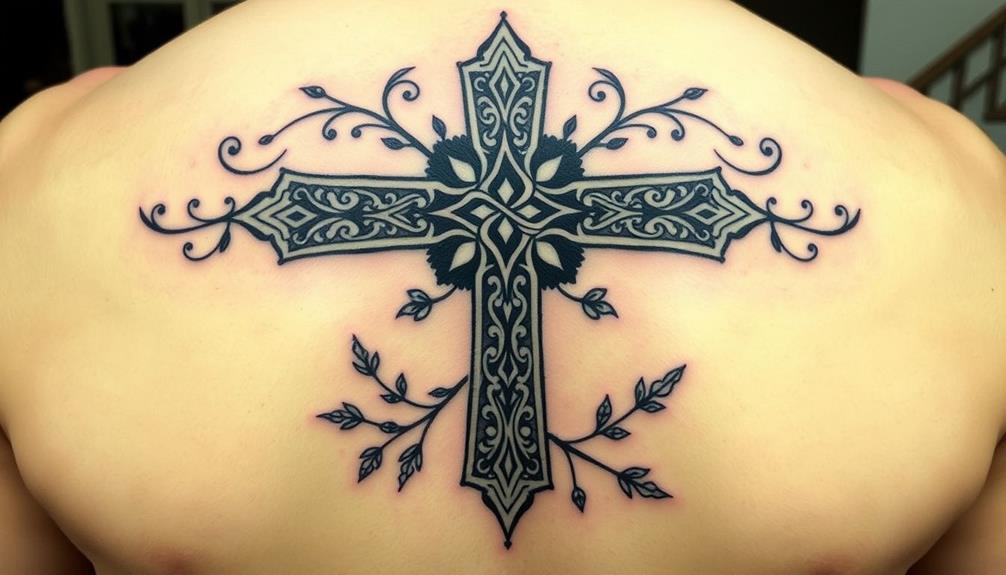
The Coptic cross isn't just a symbol, it's a spiritual connection that dates back centuries. Its origins and significance are deeply rooted in the history of the Coptic Orthodox Church, and its design holds a significant meaning that has touched the lives of many.
Today, people from all walks of life are drawn to this powerful emblem, each finding their own unique interpretation and cultural impact in its intricate design.
Origins and Significance
As I investigate the origins and significance of Coptic cross tattoos, it's essential to recognize their deep spiritual connections. The Coptic cross, with its intricate design and rich symbolism, represents a powerful expression of faith for many Egyptian Christians.
Let me share with you three key aspects that make these tattoos truly special:
- *Coptic craftsmanship*: The unique style of the Coptic cross showcases the artistic heritage of the Coptic Orthodox Church, reflecting centuries of devotion and tradition.
- *Tattoo symbolism*: By permanently inking the cross on their bodies, believers create a meaningful connection with their faith, carrying a constant reminder of God's love and protection.
- *Spiritual identity*: For many Copts, these tattoos serve as badges of honor, signifying their steadfast commitment to their religious beliefs and cultural heritage.
Through the artistry of Coptic craftsmanship, these tattoos become more than just skin deep—they embody the essence of one's spiritual odyssey.
When I see a Coptic cross tattoo, I'm reminded of the strength and resilience of the Coptic people, who've maintained their faith through centuries of adversity. It's a confirmation of the power of symbolism and the enduring nature of the human spirit.
Modern Interpretations
Exploring modern interpretations of Coptic cross tattoos reveals a fascinating blend of tradition and contemporary spirituality. As I investigate the world of modern styles, I'm struck by the creativity and skill of contemporary artists who are reimagining this ancient symbol. These tattoos aren't merely ink on skin; they're powerful expressions of faith, identity, and personal beliefs.
Today's Coptic cross designs often incorporate intricate patterns, bold colors, and innovative techniques that breathe new life into this timeless icon. Some artists combine the cross with other meaningful symbols, such as ankhs or doves, to create unique and deeply personal pieces.
Others experiment with abstract or minimalist styles, capturing the essence of the cross in a few graceful lines.
What I find most captivating about modern Coptic cross tattoos is the way they bridge the gap between the past and the present. They honor the rich history and significance of the symbol while allowing individuals to connect with it in their own way.
For many, these tattoos aren't just a fashion statement but a significant expression of their spiritual path and a reminder of the enduring power of faith in their lives.
Cultural Impact
Coptic cross tattoos, with their deep spiritual connections, have left a permanent mark on the cultural scenery.
As I've seen firsthand, these tattoos are more than just ink on skin; they're a powerful form of cultural exchange and artistic expression.
Let me share with you three key aspects that make them truly special:
- *Heritage*: They're a vivid reminder of Egypt's ancient Christian heritage, carrying the weight of centuries of faith and tradition.
- *Identity*: For many, getting a Coptic cross tattoo is a significant statement of identity, marking them as part of a community with deep roots.
- *Beauty*: The intricate designs of these crosses, often incorporating lotus flowers or other symbols, showcase the artistic prowess of the tattooists.
Through the needle's point, the spiritual and the artistic merge, creating a form of expression that connects across cultures and time.
It's a reflection of the enduring power of faith and the human desire for beauty and meaning, etched in the very skin of the believer.
Preserving Heritage

Many Copts choose to get a Coptic cross tattoo as a way of preserving their heritage and identity. This ancient tradition, dating back centuries, is a powerful way to guarantee cultural continuity in the face of adversity and change.
I've seen firsthand how these tattoos serve as dignified symbols of resilience and faith for the Coptic community. When I speak with those who bear these sacred marks, I'm always struck by the intense connection they feel to their ancestors and the rich history of their people.
It's a tangible reminder of the sacrifices made by previous generations to keep their faith and traditions alive. By permanently etching this emblem of their heritage onto their skin, they're making a bold statement about who they're and where they come from.
In a world that often seeks to erase or assimilate minority cultures, the act of getting a Coptic cross tattoo is a powerful form of resistance. It's a way of saying, "I am here, and my culture matters."
As I continue to investigate the deep significance of these tattoos, I'm continually inspired by the strength and dignity of the Coptic people in preserving their unique heritage.
Frequently Asked Questions
Are Coptic Cross Tattoos Only for Members of the Coptic Orthodox Church?
While Coptic cross tattoos have deep cultural significance and religious meaning for members of the Coptic Orthodox Church, I don't believe they're exclusively reserved for them. It's a personal choice reflecting one's faith and heritage.
Can I Get a Coptic Cross Tattoo if I'm Not Egyptian?
You can get a Coptic cross tattoo if it holds personal significance to you, even if you're not Egyptian. It's about cultural appreciation, not appropriation. I believe tattoos should reflect your own spiritual path and beliefs.
How Much Does a Typical Coptic Cross Tattoo Cost?
The cost of a Coptic cross tattoo varies depending on the artist and design complexity. I'd recommend consulting a few tattoo artists for estimates. Remember, the meaning behind your Coptic cross is more significant than the price tag.
Is It Painful to Get a Coptic Cross Tattoo on the Wrist?
Getting a Coptic cross tattoo on your wrist can be quite painful due to the area's sensitivity. However, with proper tattoo aftercare, you'll find that the stunning result is well worth a bit of discomfort during the process.
What Are Some Common Misconceptions About Coptic Cross Tattoos?
Many people assume coptic cross tattoos are just religious symbols, but their cultural significance runs much deeper. The intricate design variations reflect centuries of tradition and faith. Don't underestimate the rich history behind this powerful ink.
